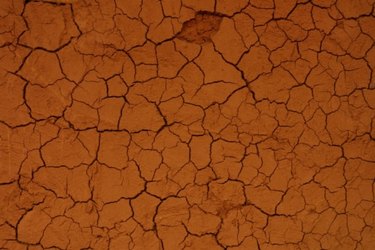Things You'll Need
Liquid polymer clay
Paintbrush or syringe
Piece of chalk
Piece of cloth
Heat gun
Pigments or oil colors (optional)
Superglue or epoxy putty (optional)

Polymer clay, also known as polyclay, is a medium that is often used to make clay figurines or sculptures. The clay hardens if baked in a regular oven at temperatures below 300 degrees F. Cracks in polymer clay sculpts form due to sudden temperature changes or when you use the clay to cover a different type of material such as air-dry clay, which dilates or contracts. Fixing cracks is possible both before and after the baking process.
Step 1
Fix cracks prior to baking the clay by applying liquid polymer clay with a paintbrush over the sculpture.
Video of the Day
Step 2
Bake your sculpture to the temperature indicated on the material you use (between 225 and 275 degrees F.) for the amount of time indicated (typically 15 to 20 minutes).
Step 3
Identify all the areas that have cracks after baking and mark them with a piece of chalk.
Step 4
Fill the cracks with liquid polymer clay using a paintbrush or a syringe, if the cracks are larger.
Step 5
Wipe off the excess of material and the chalk marks with a clean piece of cloth.
Step 6
Use a heat gun to set liquid polyclay prior to baking if fixing cracks on vertical or curved surfaces.
Step 7
Bake in the oven for the amount of time indicated on the liquid polyclay you use. Polymer clay can be baked several times, as long as you preserve the oven temperatures below 300 degrees F.
Tip
Tint the liquid polymer clay to obtain the color of your sculpture. Use oil colors or natural pigments. Avoid water-based paints, which could create a rough texture in the areas you fix due to the fact that the water evaporates. Wipe off drips of liquid polymer clay with paper towels. Remove any dried stains with a solution containing 91% isopropyl alcohol. Instead of liquid polymer clay, use superglue or cyanoacrylate, so your sculpture doesn't require an additional baking. For larger cracks, use two-part epoxy putty.
Warning
Don't touch your clay sculpts while they cool off after the baking, because this may cause cracks. Never bake polyclay at temperatures above 300 degrees F., as this causes the material to burn and turn black. When baking a sculpture that has been treated with liquid polyclay, it will yield a stronger odor than when you bake solid polymer clay. The material is not toxic, but it's best if you bake your sculpture in a well-ventilated space.
Video of the Day